|
Wie kann ich erreichen, dass die Pfeilspitze nicht durchgehend gezeichnet wird. Ziel: Solche Pfeile erstellen: BTW: Es muss nicht die Pfeilspitze \documentclass[a4paper, landscape]{scrartcl} \usepackage{tikz} \usetikzlibrary{arrows.meta} %\usetikzlibrary{shapes.arrows} \pagestyle{empty} \begin{document} \def\m{2pt} \begin{tikzpicture}[ overlay, transform shape, remember picture, shift={(current page.center)}, % Pfeil/.style={ line width=\m, double distance=1.5*\m, arrows = {-Latex[length=0pt 3 0, fill=white]}, line cap=rect, } ] \def\L{2} \coordinate[label=A] (A) at (-\L,-\L); \coordinate[label=B] (B) at (\L,-\L); \coordinate[label=C] (C) at (\L,\L); \coordinate[label=D] (D) at (-\L,\L); %\draw[] (A) rectangle (C); \draw [Pfeil] (A) -- (C); \end{tikzpicture} |
|
Im von @saputello verlinkten Beispiel geht es durch Nachzeichnen der Pfeile mit der Ganzes Beispiel: \documentclass[a4paper, landscape]{scrartcl} \usepackage{tikz} \usetikzlibrary{arrows.meta} %\usetikzlibrary{shapes.arrows} \pagestyle{empty} \begin{document} \def\L{8 cm} \def\m{2mm} \begin{tikzpicture}[ overlay, transform shape, remember picture, shift={(current page.center)}, % every node/.style={ draw, circle, fill=black, font=\sffamily\bfseries\Huge, text=white, outer sep=2*\m, }, Pfeil/.style={ line width=0.5\m, double distance=1.5*\m, arrows = {-Latex[length=0pt 3 0, fill=white]}, line cap=rect, %shorten >=5mm, }, InnerWhite/.style={white, line width=0.15*\m, shorten >= 11.3/2*\m, double distance=1.2*\m, } ] \coordinate[label=A] (A) at (-\L,-\L); \coordinate[label=B] (B) at (\L,-\L); \coordinate[label=C] (C) at (\L,\L); \coordinate[label=D] (D) at (-\L,\L); \coordinate[label=M] (M) at (-\L,0); \coordinate[label=N] (N) at (\L,0); % Rechteck %\draw[] (A) rectangle (C); % 12 \draw [Pfeil] (C) node[above right]{1} -- (A) ; \draw [InnerWhite] (C) -- (A) ; \draw [Pfeil,] ([xshift=-6*\m]A) node[below left]{2} -- ([xshift=-6*\m]C); \draw [InnerWhite] ([xshift=-6*\m]A) -- ([xshift=-6*\m]C); % 3 4 \draw [Pfeil] (B) node[below right]{3} -- (D) ; \draw [InnerWhite] (B) -- (D) ; \draw [Pfeil,] ([xshift=-6*\m]D) node[above left]{4} -- ([xshift=-6*\m]B); \draw [InnerWhite] ([xshift=-6*\m]D) -- ([xshift=-6*\m]B); % 6 7 \draw [Pfeil] ([yshift=-3*\m]M) node[left]{6} -- ([yshift=-3*\m]N); \draw [InnerWhite] ([yshift=-3*\m]M) -- ([yshift=-3*\m]N); \draw [Pfeil] ([yshift=3*\m]N) node[right]{7} -- ([yshift=3*\m]M); \draw [InnerWhite] ([yshift=3*\m]N) -- ([yshift=3*\m]M); % 5 \node[xshift=-3*\m]{5}; \end{tikzpicture} \end{document} |
|
Hier ist noch eine Alternative von https://tex.stackexchange.com/a/432143/121799. \documentclass{article} \usepackage{tikz} \usetikzlibrary{decorations,decorations.text} % decorations.text just 4 fun \pgfkeys{/tikz/.cd, outlined arrow width/.store in=\OutlinedArrowWidth, outlined arrow width=10pt, outlined arrow step/.store in=\OutlinedArrowStep, outlined arrow step=1pt, outlined arrow length/.store in=\OutlinedArrowLength, outlined arrow length=5pt, } \pgfdeclaredecoration{outlined arrow}{initial} {% initial arrow butt \state{initial}[width=\OutlinedArrowStep,next state=cont] { \pgfmoveto{\pgfpoint{\OutlinedArrowStep}{\OutlinedArrowWidth/2}} \pgfpathlineto{\pgfpoint{0.3\pgflinewidth}{\OutlinedArrowWidth/2}} \pgfpathlineto{\pgfpoint{0.3\pgflinewidth}{-\OutlinedArrowWidth/2}} \pgfpathlineto{\pgfpoint{1pt}{-\OutlinedArrowWidth/2}} \pgfcoordinate{lastup}{\pgfpoint{1pt}{\OutlinedArrowWidth/2}} \pgfcoordinate{lastdown}{\pgfpoint{1pt}{-\OutlinedArrowWidth/2}} \xdef\marmotarrowstart{0} } \state{cont}[width=\OutlinedArrowStep]{ \ifdim\pgfdecoratedremainingdistance>\OutlinedArrowLength% continue the outlined path \pgfmoveto{\pgfpointanchor{lastup}{center}} \pgfpathlineto{\pgfpoint{\OutlinedArrowStep}{\OutlinedArrowWidth/2}} \pgfcoordinate{lastup}{\pgfpoint{\OutlinedArrowStep}{\OutlinedArrowWidth/2}} \pgfmoveto{\pgfpointanchor{lastdown}{center}} \pgfpathlineto{\pgfpoint{\OutlinedArrowStep}{-\OutlinedArrowWidth/2}} \pgfcoordinate{lastdown}{\pgfpoint{\OutlinedArrowStep}{-\OutlinedArrowWidth/2}} \else \ifnum\marmotarrowstart=0% draw the arrow head \pgfmoveto{\pgfpointadd{\pgfpointanchor{lastup}{center}}{\pgfpoint{-0.5\pgflinewidth}{0}}} \pgflineto{\pgfpoint{-0.5\pgflinewidth}{\OutlinedArrowWidth}} \pgflineto{\pgfpointadd{\pgfpointdecoratedpathlast}{\pgfpoint{-0.5\pgflinewidth}{0}}} \pgflineto{\pgfpoint{-0.5\pgflinewidth}{-\OutlinedArrowWidth}} \pgflineto{\pgfpointadd{\pgfpointanchor{lastdown}{center}}{\pgfpoint{-0.5\pgflinewidth}{0}}} \xdef\marmotarrowstart{1} \else \fi \fi% } \state{final}[width=5pt] { % perhaps unnecessary but doesn't hurt either \pgfmoveto{\pgfpointdecoratedpathlast} } } \begin{document} \begin{tikzpicture}[decoration=outlined arrow,font=\sffamily] \pgfmathsetmacro{\L}{2} \coordinate[label=A] (A) at (-\L,-\L); \coordinate[label=B] (B) at (\L,-\L); \coordinate[label=C] (C) at (\L,\L); \coordinate[label=D] (D) at (-\L,\L); \draw[decorate,blue,opacity=0.5] (A) to (C); \begin{scope}[xshift=5cm] \coordinate[label=A] (A) at (-\L,-\L); \coordinate[label=B] (B) at (\L,-\L); \coordinate[label=C] (C) at (\L,\L); \coordinate[label=D] (D) at (-\L,\L); \draw[decorate,outlined arrow length=15pt] (A.east) to[out=0,in=-180] (C.west); \fill[decoration={text along path, text={~here is some text inside an arrow}, raise=-2.5pt},decorate] (A.east) to[out=0,in=-180] (C.west); \end{scope} \end{tikzpicture} \end{document} Eine andere Möglichkeit ist, shapes.arrows zu verwenden, siehe den Kommentar von cis und https://tex.stackexchange.com/a/432147/121799. Pro: etwas kürzer und einfacher zu modifizieren, z.B. Füllen der Pfeile. Contra: keine gekrümmten Pfeile. \documentclass{standalone} \usepackage{tikz} \usetikzlibrary{calc,shapes.arrows} \pgfkeys{/tikz/.cd, fat arrow width/.store in=\FatArrowWidth, fat arrow width=2pt, } \newcommand\importantstuff[3][]{ % https://tex.stackexchange.com/a/40855/121799 \node[black!15!white,scale=2] at ([xshift=0.5mm,yshift=-0.5mm]#2) {\sffamily\textbf{#3}}; \node[#1,scale=2] (#3) at (#2) {\sffamily\textbf{#3}}; } \begin{document} \begin{tikzpicture}[ fat arrow/.style={ every to/.style={ to path={ let \p1 = ($(\tikztotarget)-(\tikztostart)$), \n1 = {veclen(\x1,\y1)}, \n2 = {mod(scalar(atan2(\y1,\x1))+360, 360)} % calculate angle in range [0,360) in -- (\tikztotarget) node[draw, inner xsep=0pt,inner ysep=\FatArrowWidth, % use inner ysep to set width minimum height={\n1-\pgflinewidth}, single arrow, single arrow head extend=1.5mm, rotate=\n2, % not shape border rotate, because that for some reason didn't work anchor=tip,#1 ] {} \tikztonodes} }}] \importantstuff[yellow]{60:2}{1} \importantstuff[yellow]{240:2}{2} \importantstuff[yellow]{300:2}{3} \importantstuff[yellow]{120:2}{4} \importantstuff[yellow]{180:2}{6} \importantstuff[yellow]{0:2}{7} \path[fat arrow={fill=white}] (127:1.7) to (293:1.5); \path[fat arrow={fill=white}] (307:1.7) to (113:1.5); \path[fat arrow={fill=white}] (233:1.7) to (67:1.5); \path[fat arrow={fill=white}] (53:1.7) to (247:1.5); \path[fat arrow={fill=white}] (7:1.7) to (173:1.5); \path[fat arrow={fill=white}] (187:1.7) to (-7:1.5); \importantstuff[yellow]{0:0}{5} \end{tikzpicture} \end{document} Das Ergebnis sieht gut aus, aber scheint mir reichlich kompliziert umgesetzt.
Ich dachte anfangs, man könne ggf. den
(03 Jul '18, 00:33)
cis
@cis Über kompliziert oder nicht möchte ich hier nicht streiten, aber das mit den shapes geht natürlich schon, siehe https://tex.stackexchange.com/a/432147/121799. Der Grund warum ich das nicht 100% mag, ist dass man damit keine gekrümmten Pfeile hinkriegt. (Aber meine Lösung geht auch schief, wenn die Pfeile stark gekrümmt sind...)
(03 Jul '18, 02:46)
Community
|

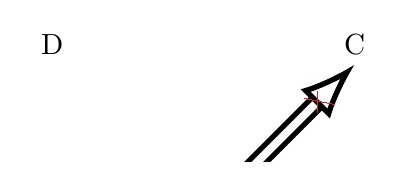
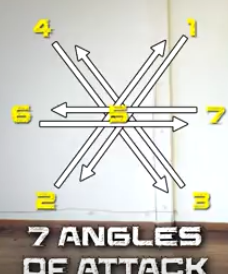
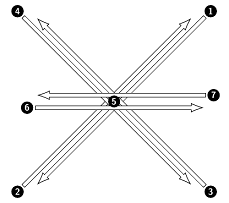
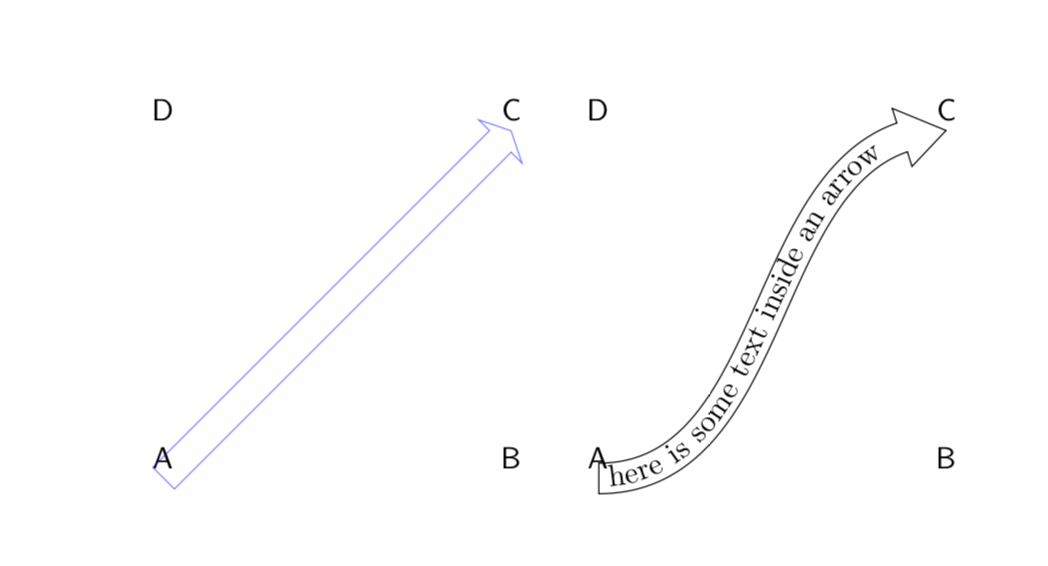
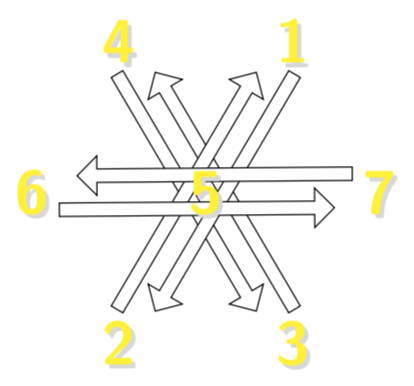
Zwei Alternativen: https://tex.stackexchange.com/questions/404739/drawing-empty-large-arrow oder http://www.texample.net/tikz/examples/double-arrows/
Da vermutlich eher die zweitere Alternative, weil sich
drawbesser zwischen Koordinaten eignet. Mmmh, mal verstehen, was er da gemacht hat.